History of Antarctica
The history of Antarctica emerges from early Western theories of a vast continent, known as Terra Australis, believed to exist in the far south of the globe. The doubling of the Cape of Good Hope and Cape Horn in the 15th century and 16th century proved that Terra Australis Incognita ("Unknown Southern Land") was a continent in its own right. In 1773 James Cook crossed the Antarctic Circle for the first time but although he discovered nearby islands, he did not catch sight of Antarctica itself.
In 1820 several expeditions claimed to have been the first to have sighted Antarctica. The first landing was probably just over a year later when American Captain John Davis, a sealer, set foot on the ice. Once the North Pole had been reached in 1831 several expeditions attempted to reach the Southern Pole. Many resulted in injury and death. The Norwegian Roald Amundsen finally claimed the prize following a dramatic race with the Briton Robert Falcon Scott in December 1911.
The search for Terra Australis Incognita
In the Western world, belief in a Terra Australis - a vast continent located in the far south of the globe to "balance" out the northern lands of Europe, Asia and North Africa - had existed for centuries. Aristotle had postulated a symmetry of the earth, which meant that there would be equally habitable lands south of the known world. The Greeks suggested that these two hemispheres, north and south, were divided by a 'belt of fire'[citation needed].
It was not until Prince Henry the Navigator began in 1418 to encourage the penetration of the torrid zone in the effort to reach India by circumnavigating Africa that the exploration of the southern hemisphere began. In 1473 Portuguese navigator Lopes Gonçalves proved that the equator could be crossed, and cartographers and sailors began to assume the existence of another, temperate continent to the south of the known world.
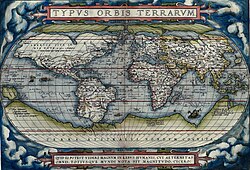
The doubling of the Cape of Good Hope in 1487 by Bartholomew Diaz first brought explorers within touch of the Antarctic cold, and proved that there was an ocean separating Africa from any Antarctic land that might exist. Ferdinand Magellan, who passed through the Straits of Magellan in 1520, assumed that the islands of Tierra del Fuego to the south were an extension of this unknown southern land, and it appeared as such on a map by Ortelius: Terra australis recenter inventa sed nondum plene cognita ("Southern land recently discovered but not yet known").[citation needed]. In 1513, the Turkish admiral Piri Reis also drew a a map that has been said to show part of the Antarctic continent.
The doubling of Cape Horn by Drake in 1578 proved that the Tierra del Fuego archipelago was of small extent and that any continent which lay to the south must be within the region of perpetual winter. European geographers connected the coast of Tierra del Fuego with the coast of New Guinea on their globes and allowing their imaginations to run riot in the vast unknown spaces of the south Atlantic, south Indian and Pacific oceans. They sketched the outlines of the Terra Australis Incognita ("Unknown Southern Land"), a vast continent stretching in parts into the tropics. The search for this great south land or Third World was a leading motive of explorers in the 16th and the early part of the 17th centuries.
Schouten and Le Maire rediscovered the southern extremity of Tierra del Fuego and named it Cape Horn in 1615. Quirós in 1606 took possession for the king of Spain all of the lands he had discovered in Australia del Espiritu Santo (the New Hebrides) and those he would discover "even to the Pole". Tasman in 1642 showed that New Holland (Australia) was separated by sea from any continuous southern continent.
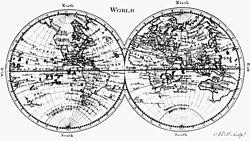
Voyagers round the Horn frequently met with contrary winds and were driven southward into snowy skies and ice-encumbered seas; but so far as can be ascertained none of them before 1770 reached the Antarctic Circle, or knew it, if they did. The story of the discovery of land in 64° S. by Dirk Gerritz on board the Blijde Boodschap in 1599 was shown to be the result of a mistake[citation needed] of a commentator, Kasper Barlaeus, in 1622. A similar story of sighting "snow-covered mountains" beyond the 64° S in 1603 is told of the Spanish Gabriel de Castilla[1]. There was controversy over whether South Georgia was sighted in 1675 by La Roche. It may safely be said that all the navigators who fell in with the southern ice up to 1750 did so by being driven off their course and not of set purpose. An exception may perhaps be made in favor of Halley's voyage in HMS Paramour for magnetic investigations in the South Atlantic when he met the ice in 52° S. in January 1700; but that latitude was his farthest south. A determined effort on the part of the French naval officer Pierre Bouvet to discover the South Land described by a half legendary sieur de Gonneyville resulted only in the discovery of Bouvet Island in 54°10' S., and in the navigation of 48 degrees of longitude of ice-cumbered sea nearly in 55° S. in 1730.
In 1771 Yves Joseph Kerguelen sailed from France with instructions to proceed south from Mauritius in search of "a very large continent." He lighted upon a land in 50° S. which he called South France, and believed to be the central mass of the southern continent. He was sent out again to complete the exploration of the new land, and found it to be only and inhospitable island which the renamed in disgust the Isle of Desolation, but in which posterity has recognized his courageous efforts by naming it Kerguelen Land.[2]
South of the Antarctic Circle
The obsession of the undiscovered continent culminated in the brain of Alexander Dalrymple, the brilliant and erratic hydrographer who was nominated by the Royal Society to command the Transit of Venus expedition to Tahiti in 1769. The command of the expedition was given by the admiralty to Captain James Cook. Sailing in 1772 with the Resolution, a vessel of 462 tons under his own command and the Adventure of 336 tons under Captain Tobias Furneaux, Cook first searched in vain for Bouvet Island, then sailed for 20 degrees of longitude to the westward in latitude 58° S., and then 30° eastward for the most part south of 60° S., a higher southern latitude than had ever been voluntarily entered before by any vessel. On January 17, 1773 the Antarctic Circle was crossed for the first time in history and the two ships reached 67° 15' S. in 39° 35' E., where their course was stopped by ice.
There Cook turned northward to look for French Southern and Antarctic Lands, of the discovery of which he had received news at Cape Town, but from the rough determination of his longitude by Kerguelen, Cook reached the assigned latitude 10° too far east and did not see it. He turned south again and was stopped by ice in 61° 52' S. and 95° E. and continued eastward nearly on the parallel of 60° S. to 147° E. where on March 16th the approaching winter drove him northward for rest to New Zealand and the tropical islands of the Pacific. In November 1773 Cook left New Zealand, having parted company with the Adventure, and reached 60° S. in 177° W., whence he sailed eastward keeping as far south as the floating ice allowed. The Antarctic Circle was crossed on the 20th of December and Cook remained south of it for three days, being compelled after reaching 67° 31' S. to stand north again in 135° W.
A long detour to 47° 50' S.. served to show that there was no land connection between New Zealand and Tierra del Fuego, and turning south again Cook crossed the Antarctic Circle for the third time in 109° 30' W., and four days later his progress was blocked by ice in 71° 10' S., 106° 54' W. This point, reached on January 30 1774, was the farthest south attained in the 18th century. With a great detour to the east, almost to the coast of South America, the expedition regained Tahiti for refreshment. In November 1774 Cook started from New Zealand and crossed the South Pacific without sighting land between 53° and 57° S. to Tierrra del Fuego, then passing Cape Horn on the 29th of December he discovered the Isle of Georgia and Sandwich Land, the only ice-clad land he had seen, and crossed the South Atlantic to the Cape of Good Hope between 55° and 60°.. He thereby laid open the way for future Antarctic exploration by exploding the myth of a habitable southern continent. Cook's most southerly discovery of land lay on the temperate side of the 60th parallel, and he convinced himself that if land lay farther south it was practically inaccessible and of no economic value.[2]
The first land south of the parallel 60° south latitude was discovered by the Englishman William Smith, who sighted Livingston Island on 19 February 1819. Few months later Smith returned to explore the other islands of the South Shetlands archipelago, landed on King George Island, and claimed the new territories for Britain.
First sighting of land
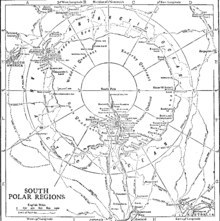
The Spanish Navy ship San Telmo sank in September 1819 when trying to cross Cape Horn. Parts of her wreckage were found months later by sealers on the north coast of Livingston Island (South Shetlands). It is unknown if some survivor managed to be the first setting foot on these Antarctic islands.
The first confirmed sighting of Antarctica cannot be accurately attributed to one single person. It can, however, be narrowed down to three individuals. According to various sources [1] [2] [3][4], three men all sighted Antarctica within days or months of each other: Fabian von Bellingshausen (a captain in the Russian Imperial Navy), Edward Bransfield (a captain in the British navy), and Nathaniel Palmer (an American sealer out of Stonington, Connecticut). It is certain that on January 28, 1820 (New Style), the expedition led by Fabian von Bellingshausen and Mikhail Petrovich Lazarev on two ships reached a point within 20 miles (40 km) of the Antarctic mainland and saw ice-fields there. On January 30, 1820, Bransfield sighted Trinity Peninsula, the northernmost point of the Antarctic mainland, while Palmer sighted the mainland in the area south of Trinity Peninsula in November 1820. Bellingshausen's expedition also discovered Peter I Island and Alexander I Island, the first islands to be discovered south of the circle.
Exploration
Only slightly more than a year later, the first landing on the Antarctic mainland was arguably by the American Captain John Davis, a sealer, who claimed to have set foot there on February 7 1821, though this is not accepted by all historians.[5][6].

Nathaniel Palmer, an American sealer looking for seal breeding grounds sighted what is now known as the Antarctic Peninsula on the northwestern quadrant of the continent in December 1821. In 1823, James Weddell, a British sealer sailed into what is now known as the Weddell Sea.
The first person to realize that he had actually discovered a whole continent was Charles Wilkes who commanded a United States Navy expedition.[3] His 1840 voyage discovered what is now known as Wilkes Land, on the southeast quadrant of the continent.
After the North Magnetic Pole was located in 1831, explorers and scientists began looking for the South Magnetic Pole. One of the explorers, James Clark Ross, a British naval officer, identified its approximate location, but was unable to reach it on his trip in 1841. Commanding the British ships Erebus and Terror, he braved the pack ice and approached what is now known as the Ross Ice Shelf, a massive floating ice shelf over 100 feet high. His expedition sailed eastward along the southern Antarctic coast discovering mountains which were since named after his ships: Mount Erebus, the most active volcano on Antarctica, and Mount Terror.[3].
The first documented landing on the mainland of East Antarctica was by the American sealer Mercator Cooper on January 26, 1853 aboard the Levant at Victoria Land.[4]
In 1897, an expedition led by Belgian Adrian de Gerlache left Antwerp, Belgium for Antarctica. The multi-national crew included a Romanian zoologist (Emil Racoviţă), a Polish geologist (Henryk Arctowski), a Belgian navigator/astronomer (George Lecointe), several Norwegians, including Roald Amundsen, and an American surgeon, Dr. Frederick Cook. In 1898, they became the first men to spend winter on Antarctica, when their ship Belgica became trapped in the ice. They became stuck on February 28, 1898, and only managed to get out of the ice on March 14, 1899. During their forced stay, several men lost their sanity, not only because of the Antarctic winter night and the endured hardship, but also because of the language problems between the different nationalities. A year later a British expedition commanded by Norwegian Carstens Borchgrevink became the first to intentionally spend winter on the continent itself.[3][5]
British National Antarctic Expedition (Discovery)
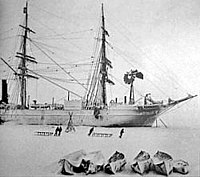
The British National Antarctic Expedition (1901 - 1904), led by Robert Falcon Scott, came to within 857 km (463 nautical miles) of the South Pole from its base at McMurdo Sound.
Scottish National Antarctic Expedition
In 1903 the Scottish National Antarctic Expedition established Osmond House, a meteorological observatory on Laurie Island in the South Orkneys. A year later, ownership was passed to Argentina and renamed to Orcadas Base, the continent's oldest permanent base[7], and the only one present for roughly the next 40 years.
British Imperial Antarctic Expedition (Nimrod)
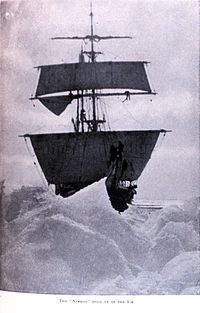
Ernest Shackleton, who had been a member of Scott's expedition, organized and led the British Imperial Antarctic Expedition (1907-09), again with the primary objective of reaching the South Pole, and came within 180 km (97 nautical miles) before having to turn back. On this expedition, again based at McMurdo Sound, Shackleton, discovered the Beardmore Glacier and was the first to reach the polar plateau. During this expedition, parties led by T. W. Edgeworth David became the first to climb Mount Erebus and to reach the South Magnetic Pole.
Race to the Pole (Fram and Terra Nova)
On December 14, 1911, a party led by Norwegian polar explorer Roald Amundsen from the ship Fram became the first to reach the South Pole, using a route from the Bay of Whales (his camp Polheim and up the Axel Heiberg Glacier. Amundsen was followed by Robert Falcon Scott from the Terra Nova over a month later, using the route pioneered by Shackleton. Scott's party later died on the return journey after being delayed by a series of accidents, bad weather, and the declining physical condition of the men. The Amundsen-Scott South Pole Station was later named after these two men.
Imperial Trans-Antarctic Expedition (Endurance)

The Imperial Trans-Antarctic Expedition of 1914, led by Ernest Shackleton, set out to cross the continent via the pole, but their ship, the Endurance, was trapped and crushed by pack ice before they even landed. The expedition members survived after an epic journey on sledges over pack ice to Elephant Island. Then Shackleton and five others crossed the Southern Ocean, in an open boat called James Caird, and then trekked over South Georgia to raise the alarm at the whaling station Grytviken.
Exploration by air: 30s, 40s and 50s
US Navy Rear Admiral Richard Evelyn Byrd led five expeditions to Antarctica during the 1930s, 1940s, and 1950s. He overflew the South Pole with pilot Bernt Balchen on November 28 and 29, 1929, to match his overflight of the North Pole in 1926. Byrd's explorations had science as a major objective and pioneered the use of aircraft on the continent. Byrd is credited with doing more for Antarctic exploration than any other explorer. His expeditions set the scene for modern Antarctic exploration and research. It was not until October 31 1956 that anyone set foot on the south pole again; on that day US Navy Rear Admiral George Dufek[8] (and others) successfully landed a R4D Skytrain (Douglas DC-3) aircraft.
During the International Geophysical Year of 1957 a large number of expeditions were mounted.
Commonwealth Trans-Antarctic Expedition

In 1956, a United States Navy expedition set up the first permanent based at the South Pole, Amundsen-Scott South Pole Station, by airlift, to support the International Geophysical Year. In 1958, Edmund Hillary's party in the New Zealand party of the Commonwealth Trans-Antarctic Expedition became the third group in history to reach the South Pole by land, and the first group of motor vehicles to reach the pole. The British team led by Vivian Fuchs, met them at the pole shortly afterwards. The expedition completed the first overland crossing of the continent by land via the South Pole.[3] New Zealand mountaineer Sir Edmund Hillary reached the Pole in early January 1958 using farm tractors equipped for polar travel, the first party since Scott's to reach the South Pole overland. Hillary was laying supply depots as part of the Commonwealth Trans-Antarctic Expedition and in typical Hillary style "detoured" to the pole because the trip had gone well. British explorer Sir Vivian Fuchs then arrived at the Pole from the opposite direction later in January, meeting Hillary. Fuchs continued on, making use of the provisions that Hillary had stored, and on March 2 succeeded in reaching Scott Base, completing the overland transpolar crossing that Shackleton had envisaged.
Recent history

The Antarctic Treaty was signed on December 1 1959 and came into force on June 23 1961. Among other provisions, this treaty limits military activity in the Antarctic to the support of scientific research.
A baby, named Emilio Marcos de Palma, was born near Hope Bay on January 7, 1978, becoming the first baby born on the continent. He also was born farther south than anyone in history. [6]
On November 28 1979, an Air New Zealand DC-10 on a sightseeing trip crashed into Mount Erebus on Ross Island, killing all 257 people on board.
In March 2002 the 5,500 km² (2,120 square statute mile) Iceberg B-22 broke off from the Thwaites Ice Tongue and the Larsen B ice shelf on the Antarctic Peninsula, and shattered into small fragments. The ice shelf was 200 metres thick and had a surface area of 3,250 square kilometres.
See also
- History of Livingston Island
- List of Antarctica expeditions
- List of research stations in Antarctica
- History of South Georgia and the South Sandwich Islands
External links
eBooks on Project Gutenberg
- The South Pole; an account of the Norwegian Antarctic expedition in the "Fram," 1910-12 — Volume 1 and Volume 2 at Project Gutenberg
- The Worst Journey in the World, Volumes 1 and 2 Antarctic 1910-1913 at Project Gutenberg
- South: the story of Shackleton's 1914-1917 expedition at Project Gutenberg
References
- ^ Don Gabriel de Castilla, primer avistador de la Antártica, by Chilean historian Isidoro Vázquez de Acuña (Spanish language)
- ^ a b This article incorporates text from a publication now in the public domain: Chisholm, Hugh, ed. (1911). "Polar Regions". Encyclopædia Britannica (11th ed.). Cambridge University Press.
- ^ a b c d "ANTARCTIC EXPLORATION - CHRONOLOGY". Quark Expeditions. 2004. Retrieved 2006-10-20.
- ^ Antarctic Circle - Antarctic First
- ^ "Carsten Borchgrevink:1864-1934". Retrieved 2006-10-20.
- ^ antarctica.org - Science: in force...
